|
|
|
Sort Order |
|
|
|
Items / Page
|
|
|
|
|
|
|
| Srl | Item |
| 1 |
ID:
175929
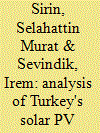

|
|
|
|
|
| Summary/Abstract |
As global investments continue in renewable energy technologies, investment costs have declined significantly. Meanwhile, many governments have shifted from pre-set renewable support schemes to auction schemes in order to introduce competition in price setting. Turkey has initiated Renewable Energy Resource Zone (RERZ) auctions to promote solar photovoltaic (PV) and wind technologies. We examine the first of these auctions, Solar PV RERZ, which has ambitious targets in terms of increasing solar PV capacity and enhancing domestic competence in solar technologies. Despite the auction being hailed as a success in terms of low prices, we utilize the Levelized Cost of Electricity generation (LCOE) analysis to demonstrate that the project is vulnerable to macroeconomic shocks and financial risks. Model results show that the capacity factor is the most prominent factor in costs, and 10% change in the capacity factor affects the LCOE about the same rate. Investment cost and interest rate are the other major factors affecting the LCOE. Based on these results, we make recommendations by discussing how Turkey can improve its auction design by incorporating some of the elements used by Brazil and South Africa.
|
|
|
|
|
|
|
|
|
|
|
|
|
|
|
|
| 2 |
ID:
103346
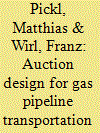

|
|
|
|
|
| Publication |
2011.
|
| Summary/Abstract |
As a response to the Russian dominance of the EU's natural gas supplies and the EU's increasing gas demands, major gas pipeline projects are currently under way to enhance the EU's energy supply security. Oftentimes to raise financing and to allocate gas transportation capacities, auctions are carried out to allow gas shippers to book transportation rights.
In recent years, auctions have emerged as one of the most successful allocation mechanisms in the microeconomic theory. However, different auction designs can lead to different outcomes making the choice of auction design a decisive one, especially for divisible-good auctions. This paper seeks to give a formulation of an optimal auction design for gas pipeline transportation capacity. Specifically three different mechanisms are tested: (i) NPV allocation; (ii) pro rata allocation; and (iii) optimization. In addition, Nabucco is taken as a case study to empirically show results of such auction designs.
Results show that a trade-off between revenue optimization and fair allocation can be observed: allocation per optimization is the favorable auction design when revenue maximization is more important than fair allocation. On the other hand, pro rata allocation is the auction design to be chosen when fairness of allocation is considered most central.
|
|
|
|
|
|
|
|
|
|
|
|
|
|
|
|
| 3 |
ID:
191224
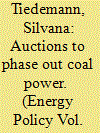

|
|
|
|
|
| Summary/Abstract |
This study assesses the extent to which auctions for compensation payments are a suitable policy instrument for ending coal-fired power generation at minimum cost and thus achieving national climate targets. Germany is the first country to apply such a market-based mechanism. Evaluating the effectiveness and efficiency of the auction, we find that the first five of seven auction rounds will retire 10 GW of coal-fired capacity at a cost of 68 ± 5 EUR/kW, corresponding to an additional carbon price of 2.4 ± 0.2 EUR/tCO2. The possibility of administratively shutting down power plants from 2024 and a decreasing ceiling price have ensured that average compensation payments are well below the ceiling price, and low compared to other policies, even though there was no competition in two of five auction rounds. As the government cancels the freed emission allowances, the policy will result in lower emissions, even though the carbon intensity of the German coal power fleet increased slightly by 2%. Thus, the German auctions can serve as a model for national phase-out strategies in countries with similar institutional frameworks and provide a reference case for integrating conflicting policy objectives into auctions.
|
|
|
|
|
|
|
|
|
|
|
|
|
|
|
|
| 4 |
ID:
169798


|
|
|
|
|
| Summary/Abstract |
This study proposes a new explanation for institutional differences of organizations in China. It focuses on how two organizational forms dominant in contemporary art markets – commercial galleries and auction houses – were first established in China in the 1990s. Based on archival and interview data, it argues that the organizational forms were introduced to China due to mimetic isomorphism, and that their divergences from the foreign models are the result of unintended consequences of institutional work. It highlights the role of individual agency, including the role of foreign nationals, in organization-building in China. The findings also have implications for institutional theory: the article shows how the political, cultural and institutional context in China shaped institutional work that needed to be conducted and led to unintended consequences of institutional work.
|
|
|
|
|
|
|
|
|
|
|
|
|
|
|
|
| 5 |
ID:
180840
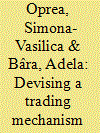

|
|
|
|
|
| Summary/Abstract |
The new potential of Distributed Energy Resources (DER), residential consumers, buildings, and prosumers in terms of controllable devices, self-generation, and storage makes them more active in the market encouraged by lower electricity prices. In addition, integrating a higher volume of volatile Renewable Energy Sources (RES) that unstress the public grid by local trading interactions is a desirable target of Local Electricity Markets (LEM). In this paper, we propose a blockchain trading mechanism to simulate the electricity transactions for 11 modern smart houses with more than 300 appliances, 8 roof- or faced-PV systems, and smart-metered 15-min readings that form a small-size community. The electricity generated at the community level lowers the electricity bills and brings benefits for prosumers (sellers) and consumers (buyers). Several trading mechanisms for LEM transactions including auctions such as Uniform Price (UP), Pay-As-Bid (PAB), Generalized Second-Price (GSP), Vickrey-Clark-Groves (VCG) methods are implemented to evaluate the benefits and show their efficiency. After the market is initially cleared, an adjustment coefficient of the price is proposed for both sides (seller and buyer) to enlarge the trading potential at the community level using blockchain technology. It proves to bring excellent results to the LEM participants and enhance trading with outstanding benefits.
|
|
|
|
|
|
|
|
|
|
|
|
|
|
|
|
| 6 |
ID:
093478


|
|
|
|
|
| Publication |
2010.
|
| Summary/Abstract |
We look at the effect of modeling branch-outage contingencies on locational marginal prices. To model contingencies in the day-ahead auction, we formulate a two-stage stochastic program. Rather than follow the current practice of including a list of possible contingencies that must be satisfied, we incorporate a larger set of contingencies in the model and allow contingencies to result in load reductions/outages at a cost. The model can be used and interpreted in two ways. One is to look at the tradeoff between reliability and outage costs. Another is to consider the load losses resulting from a contingency to be consumer offers of load reductions in response to line outages as part of the day-ahead auction. In analyzing the model structure, we find that the prices in the model closer in definition to those currently used in the day-ahead auction do not maximize expected surplus because the day-ahead auction produces prices that assume shortages will never occur. This raises issues with the design of auctions with important stochastic elements in the market. We present results for a 68-node grid with 86 branches (lines and transformers) to illustrate how prices and expected values change as the costs of outages are varied.
|
|
|
|
|
|
|
|
|
|
|
|
|
|
|
|
| 7 |
ID:
188548
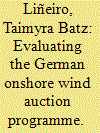

|
|
|
|
|
| Summary/Abstract |
Auctions are a highly demanded policy instrument for the promotion of renewable energy sources. Their flexible structure makes them adaptable to country-specific conditions and needs. However, their success depends greatly on how those needs are operationalised in the design elements. Disaggregating data from the German onshore wind auction programme into individual projects, we evaluated the contribution of auctions to the achievement of their primary (deployment at competitive prices) and secondary (diversity) objectives and have highlighted design elements that affect the policy's success or failure. We have shown that, in the German case, the auction scheme is unable to promote wind deployment at competitive prices, and that the design elements used to promote the secondary objectives not only fall short at achieving their intended goals, but create incentives for large actors to game the system.
|
|
|
|
|
|
|
|
|
|
|
|
|
|
|
|
| 8 |
ID:
181770


|
|
|
|
|
| Summary/Abstract |
Auctions have become the primary instrument for promoting renewable energy around the world. However, the data published on such auctions are typically limited to aggregated information (e.g., total awarded capacity, average payments). These data constraints hinder the evaluation of realisation rates and other relevant auction dynamics. In this study, we present an algorithm to overcome these data limitations in German renewable energy auction programme by combining publicly available information from four different databases. We apply it to the German solar auction programme and evaluate auctions using quantitative methods. We calculate realisation rates and—using correlation and regression analysis—explore the impact of PV module prices, competition, and project and developer characteristics on project realisation and bid values. Our results confirm that the German auctions were effective. We also found that project realisation took, on average, 1.5 years (with 28% of projects finished late and incurring a financial penalty), nearly half of projects changed location before completion (again, incurring a financial penalty) and small and inexperienced developers could successfully participate in auctions.
|
|
|
|
|
|
|
|
|
|
|
|
|
|
|
|
| 9 |
ID:
174968


|
|
|
|
|
| Summary/Abstract |
This paper examines the results of the last three renewable energy auctions in Turkey, which were carried out by using different auction designs. Our goal is to analyze the consequences by assessing the effectiveness of each method in terms of cost, realization, equality and competitiveness, in order to identify the best method and to make recommendations to the policymakers based on our past auction experiences. Our results have shown that the completion rates of the winning projects have remained relatively low in the past two auctions, mainly due to financial difficulties faced by investors, strict regulatory obligations, project-specific reasons, poor project management and intentional postponements. Although these problems may also arise in the case of recently awarded wind energy projects, the current auction scheme, which is based on the principle of offering the lowest FIT price, appears to be the most appropriate choice thanks to its contribution to the reduction of the level of support through competition. However, we propose including completion bonds to control underbidding and readjustment for the application of local content tariffs in order to achieve more efficient results in future applications.
|
|
|
|
|
|
|
|
|
|
|
|
|
|
|
|
| 10 |
ID:
186439
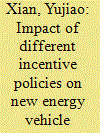

|
|
|
|
|
| Summary/Abstract |
License plate control and preferential policies are both significant for promoting New Energy Vehicles (NEVs) in China, and it is important to be aware of the impact of different policies on NEV demand. This study first conducts a survey based on questionnaires answered by 572 residents from Beijing and Shanghai. The conditional-logit model and mixed-logit model are then utilized to analyze the impact of different incentive policies (i.e., auction, lottery and queueing), vehicle attributes, and consumer attributes on China's NEV demand in gigantic cities. The results show that, i) the incentive effect of license-plate auction for purchasing NEVs is better than that of license-plate lotteries and license-plate queueing. ii) there is an evident promotion by the tax exemption policies in Beijing and Shanghai. iii) people hope that the rate of change in subsidies for battery electric vehicles (BEVs) is tied to BEV recharge mileage. iv) among those who have a high demand for purchasing a vehicle, their primary purpose is to commute to work. v) those who have BEV, live in other cities, or have urgent purchasing needs are likely not to choose NEVs. Policy implications have been proposed to promote NEVs in China's gigantic cities.
|
|
|
|
|
|
|
|
|
|
|
|
|
|
|
|
| 11 |
ID:
176663


|
|
|
|
|
| Summary/Abstract |
In this paper, the main objective is to analyze the effect of the introduction of regulated long-term tariffs in liberalized electricity generation markets, which are supposed to guarantee reasonable and predictable prices to consumers. Several authors have argued that the introduction of this kind of regulation increases competition and leads to offer prices closer to marginal costs.
Spanish electricity market brings a unique opportunity to analyze and use mandated auctions as a natural experiment (fixed-price contracts that were implemented between 2007 and 2013). The main contribution of this study is to develop and to validate the hypothesis of the existence of strong incentives to increase prices in daily electricity markets when fixed long-term tariffs are applied. Using triple difference-in-differences, we find that prices increased 15 percent 70 days before the mandated auctions (compared to a control group: Nord Pool market) and that effect disappeared once the auction was no longer carried out.
The theoretical and the empirical findings support our policy implications: The uncompetitive outcome seems to be driven by a highly concentrated market, a high elasticity to react to competitive regulations, a context of high volatility and the particularities of the auction design.
|
|
|
|
|
|
|
|
|
|
|
|
|
|
|
|
| 12 |
ID:
132754


|
|
|
|
|
| Publication |
2014.
|
| Summary/Abstract |
We study two electricity markets connected by a fixed amount of cross-border capacity. The total amount of capacity is known to all electricity traders and allocated via an auction. The capacity allocated to each bidder in the auction remains private information. We assume that traders are faced with a demand function reflecting the relationship between electricity transmitted between the markets and the spot price difference. Therefore, traders act like Bayesian-Cournot oligopolists in exercising their transmission rights when presented with incomplete information about the competitors' capacities. Our analysis breaks down the welfare effect into three different components: Cournot behavior, capacity constraints, and incomplete information. We find that social welfare increases with the level of information with which traders are endowed.
|
|
|
|
|
|
|
|
|
|
|
|
|
|
|
|
|
|
|
|
|